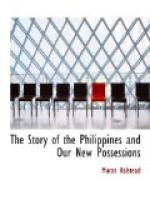On a September morning two years ago, Dr. Jose Rizal was shot by a file of soldiers on the Manila Luneta, the favorite outing park, bordering on the bay. The scene was photographed at the moment the Doctor stood erect before the firing squad, and the signal from the officer in command awaited for the discharge of the volley killing the most intellectual man of his race. Dr. Rizal is known as the Tagalo Martytr. The Tagalos are of the dominant tribe of Malays. General Aguinaldo is of this blood, as are the great majority of the insurgents. The Doctor is more than the martyr of a tribe. He is the most talented and accomplished man his people and country has produced. A history of Luzon from his pen is a hulky volume full of facts. I was not able to procure all of his books. Anyone in Manila found in possession of one of them during Spanish rule, would have been taken to the ground selected for human butchery in the appointed place of festivity, and shot as he was, making a holiday for the rulers of the islands. He wrote two novels, “Touch Us Not” and “The Filibusters,” the latter a sequel of the former. These are books using the weapons put into the hand of genius to smite oppressors in command of the force of arms. The novels are said to be interesting as novels,—rather sensational in their disregard of the personal reputation of his foes, the friars, but all along between the lines there was argument, appeals for the freedom of the Filipinos, for freedom of speech, conscience and country. There are pamphlets printed the size of an average playing card, from thirty to forty pages each, one “Don Rodriguez,” and another “The Telephone.” These I obtained in Hongkong from the hands of the niece—daughter of the sister of the Doctor,—and she presented me also his poem written when in the shadow of death, of which this volume gives a prose translation. The poem is the farewell of the author to his friends, his country and the world. It is given in prose because in that style the spirit of the poet, indeed the poetry itself, can be rendered with better results, than by striving to sustain the poetic form. The poem would be regarded as happy and affecting in the thought that is in it, the images in which the ideas gleam, the pathos of resignation, the ascendency of hope, if there were nothing in the attendant circumstances




